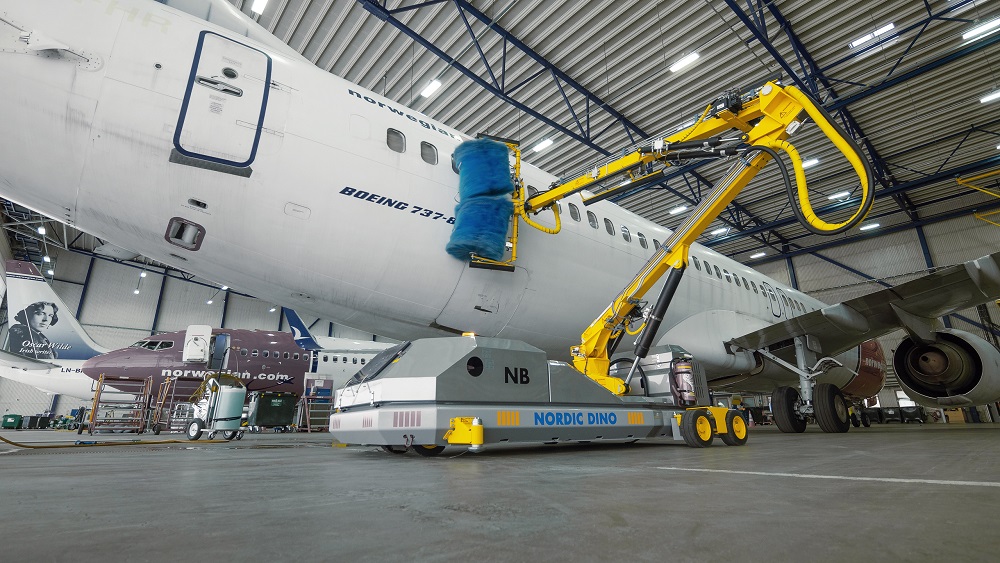Robotisation in Aviation: The Rise of Automation in the Skies
 While a world filled with AI and robots may still seem like a distant future, the reality is that they have already become an integral part of various industries, aviation included. According to Jo Alex Tanem, CEO of Nordic Dino Robotics AB, the company behind the innovative Nordic Dino system for cleaning aircraft exteriors, as technology continues to advance, robots are making their presence felt in several areas of aviation, from pilotless planes to ground handling and even passenger service.
While a world filled with AI and robots may still seem like a distant future, the reality is that they have already become an integral part of various industries, aviation included. According to Jo Alex Tanem, CEO of Nordic Dino Robotics AB, the company behind the innovative Nordic Dino system for cleaning aircraft exteriors, as technology continues to advance, robots are making their presence felt in several areas of aviation, from pilotless planes to ground handling and even passenger service.
No human in a cockpit
“Robot pilots and pilotless planes are no longer the stuff of science fiction,” Jo Alex Tanem says. “With advancements in artificial intelligence and automation, the aviation industry is exploring the concept of autonomous aircraft. These pilotless planes rely on sophisticated robotic systems that can control flight operations and make real-time decisions based on complex algorithms. While the idea of a plane flying without human pilots may raise concerns, such systems can even enhance safety and efficiency by eliminating human errors and fatigue-related risks.”
Robots maintaining the aircraft
Moving beyond the cockpit, robots are also making their mark in maintenance, repair, and overhaul (MRO) operations. “In MRO, robots are employed for tasks that require precision and repeatability, such as drilling, painting, fastening, and inspection. These automated processes not only improve the quality and speed of maintenance operations but also reduce costs. However, it’s worth noting that human oversight is still necessary to ensure the accuracy and safety of these automated processes, creating new career possibilities in this evolving field,” he explains.
Baggage handling and aircraft washing? Leave it robots
Ground handling is another area where robots are finding their place. “Aircraft washing robots, such as Nordic Dino, are used to save time, reduce the number of required staff, and increase safety. These specialised robots are designed to efficiently clean the exterior of aircraft, eliminating the need for manual labour-intensive washing procedures.”
Furthermore, Jo Alex Tanem shares that ground handling procedures might soon have some changes as an outdoor-based baggage-loading system is under development. “This system aims to automate the loading and unloading of loose passenger bags from narrow-bodied aircraft, streamlining the ground handling process and enhancing operational efficiency.”
Is it a bird? A plane? It’s a robot
Another significant challenge, expected to be eliminated by robots, is collisions with birds, also called bird strikes. “To address this issue, researchers have turned to robotic solutions - a robotic imitation of a peregrine falcon in keeping birds away from flight paths. The robotic falcon, designed to mimic the size, shape, and markings of its real-life counterpart, is used to chase flocks away from airports, mitigating the risk of bird strikes. Similarly, robotic dogs are strategically positioned around the airport perimeter to detect and deter wildlife from entering the airport grounds, preventing potential disruptions to flight traffic,” Jo Alex Tanem explains.
Robots caring for passengers
Robots are not limited to operational aspects of aviation; they are also playing a role in enhancing passenger service at airports. Remote interactive robots are being deployed in airport stores to serve customers and recommend products, aiming to provide a more engaging and enjoyable shopping experience. “These robots can assist customers, answer queries, and promote products, contributing to sales promotion efforts. Robotic check-in assistants are also being developed. They use facial recognition technology to match customers’ faces with scanned passports, check them in, and guide them to the luggage drop area, streamlining the check-in process and improving customer convenience,” he adds.
“As the aviation industry continues to embrace automation and robotics, we can expect further advancements and innovations that will shape the future of air travel. While robots may not entirely replace humans in aviation, they have the potential to revolutionise the industry, making it safer and more efficient. The future of aviation is here, and it’s taking flight on the wings of automation and robotics,” says Jo Alex Tanem, CEO of Nordic Dino Robotics AB.
